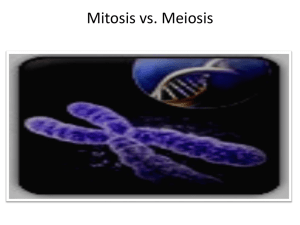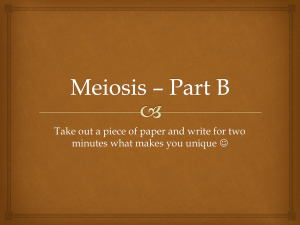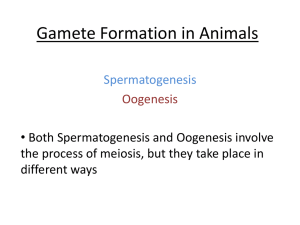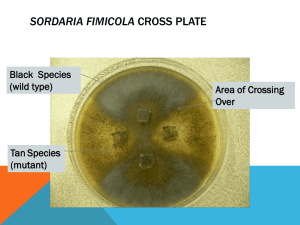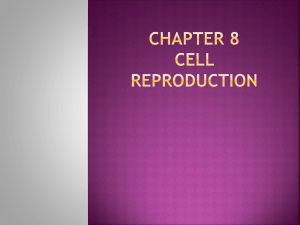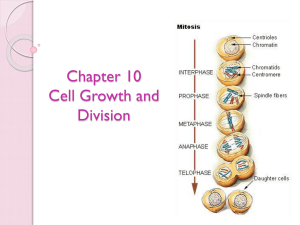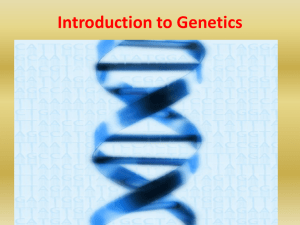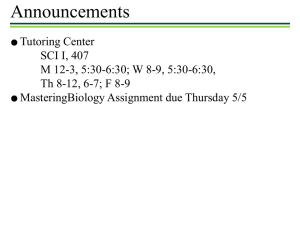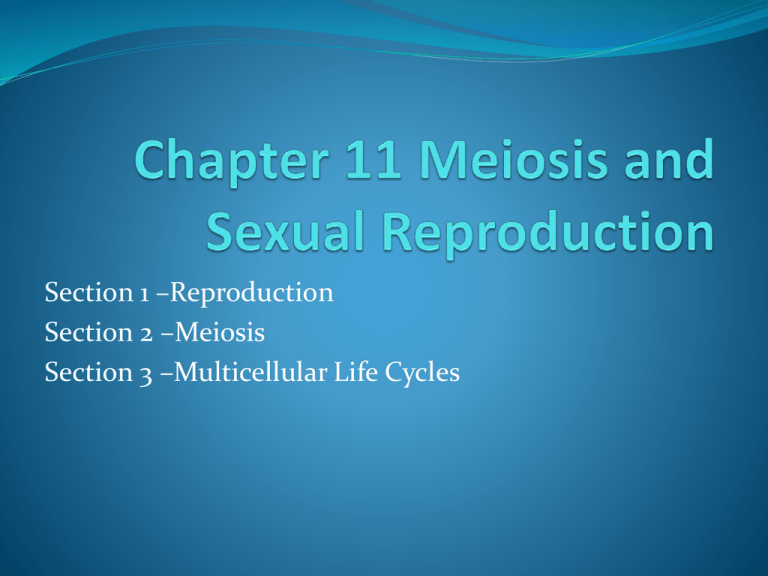
Section 1 –Reproduction
Section 2 –Meiosis
Section 3 –Multicellular Life Cycles
Reproduction
Why it Matters
Living organisms produce offspring. How closely the
offspring resemble their parents depends on how the
organism reproduces.
Reproduction is the process of producing offspring.
Some offspring are produced by two parents and
others are produced by just one parent.
Some organisms look exactly like their parents, and
others look very similar.
Whether an organism is identical or similar to its
parent is determined by the way that the organism
reproduces.
Asexual Reproduction
In asexual reproduction, a single parent passes a
complete copy of its genetic information to each of its
offspring.
An individual formed by asexual reproduction is
genetically identical to its parent.
Prokaryotes reproduce asexually by a kind of cell
division called binary fission.
Many unicellular eukaryotes also reproduce asexually.
So multicellular eukaryotes, such as starfish, go
through fragmentation.
Fragmentation is a kind of reproduction in which the
body breaks into several pieces. Some or all of theses
fragments regrow missing parts and develop into
complete adults.
Other animals such as the hydra go through budding.
In budding new individual split off from existing ones.
Some crustaceans, such as water fleas, reproduce by
parthenogenesis.
Parthenogenesis is a process in which a female makes a
viable egg that grows into an adult without a male.
Sexual Reproduction
Most eukaryotes organisms reproduce sexually.
In sexual reproduction, two parents give genetic
material to produce offspring that are genetically
different from their parents.
Each parents produces a reproductive cell, called a
gamete.
Gamete--a haploid reproduction cell that unites with
another haploid reproductive cell to form a zygote.
Zygote—the cell that results from the fusion of
gametes.
This process is called fertilization. Because both
parents give genetic material, the offspring has traits of
both parents, but not exactly alike either parent.
Germ cells and somatic cells
Cells that are specialized for sexual reproduction are
called germ cells.
Only germ cells can produce gametes.
Other body cells are called somatic cells, they do not
participate in sexual reproduction.
Advantages of Sexual Reproduction
Asexual reproduction is the simplest most efficient
way of reproduction.
Many organisms can be produced in a short period of
time without using energy to make the gametes or to
find a mate.
But genetic material with these organisms varies little
between individuals, so they may be at a disadvantage
in changing environment.
Sexual reproduction produces genetically diverse
individuals. A population of diverse organisms is
likely to have more organisms that survive a major
environmental change.
Chromosome Number
Genes are located on chromosomes.
Each chromosome has thousands of genes that
play an important role in determining how an
organism develops and functions.
Each species has a characteristic number of
chromosomes.
In humans each cell has two copies of 23 chromosomes
for a total of 46.
The gametes that form a zygote have only one copy of
each chromosome, or one set of 23 chromosomes.
This reduction of chromosomes in gametes keeps the
chromosome number of human somatic cells at a
constant 46.
Haploid and Diploid Cells
A cell such as a somatic cell has two sets of
chromosomes is diploid.
Diploid--a cell that contains two haploid sets of
chromosomes.
A cell is haploid if has only one set of chromosomes.
Diploid--describes a cell, nucleus, or organism that has
only one set of unpaired chromosomes.
Human gametes have 23 chromosomes, so n=23.
The diploid number in somatic cells is written 2n.
Human somatic cells have 46 chromosomes (2n=46).
Homologous Chromosomes
Each diploid cell has pairs of chromosomes made up of
two homologous chromosomes.
Homologous chromosomes--chromosomes that have
the same sequence of genes, that have the same
structure, and that pair during meiosis.
In humans one set of the 23 chromosomes comes from
the mother and the other set from the father.
Homologous chromosomes can carry different forms
of the genes.
Example: flower color in pea plants both could be a
gene for white, both for purple, or one of each.
Autosomes and Sex Chromosomes
Autosomes are chromosomes with genes that do not
determine the sex of an individual.
Sex chromosomes have genes that determine the sex of
an individual.
In humans and many other organisms the sex
chromosomes are referred to as the X and Y
chromosomes.
Males XY and females XX
Questions
What is fragmentation?
Fragmentation is a kind of reproduction in which the
body breaks into several pieces.
What kind of cells do germ cells produce?
Germ cells produce gametes, which are reproductive
cells.
Meiosis
Section 2 –
Why it Matters
Meiosis allows genetic information from two parents to
combine to form offspring that are different from both
parents.
Stages of Meiosis
Meiosis –a process in cell division during which the
number of chromosomes decrease to half the original
number by two divisions of the nucleus, which result
in the production of sex cells (gametes or spores).
Before meiosis begins, the chromosomes in the
original cell are copied. Meiosis involves the division
of the nucleus—Meiosis I and meiosis II.
During meiosis, a diploid cell goes through two
divisions to form four haploid cells.
In meiosis I, homologous chromosomes are separated.
In meiosis II, the sister chromatids of each
homologous are separated. As a result, four haploid
cells are formed from the original diploid cell.
Meiosis I—begins with a diploid cell that has copied its
chromosomes.
1st phase is Prophase I—
Chromosomes condense—nuclear envelope breaks
down—homologous chromosomes pair—chromatids
exchange genetic material in a process called crossingover.
Crossing-over--the exchange of genetic material
between homologous chromosomes during meiosis.
2nd Metaphase I—
Spindles remove homologous chromosomes to the
equator—homologous chromosomes remain together.
3rd Anaphase I—
Homologous chromosomes separate—spindles pull
the chromosomes of each pair to opposite poles—
chromatids do not separate at their centromere, each
chromosome is still made of two chromatids—genetic
material has recombined.
4th Telophase I–
The cytoplasm divides (cytokinesis) and two new cells
are formed—both cells have one chromosome from
each pair of homologous chromosomes.
Meiosis II—begins with the two cells formed at the
end of telophase I of meiosis I. The chromosomes are
not copied between meiosis I and meiosis II.
5th Prophase II—new spindles form.
6th Metaphase II—chromosomes line up on the
equator & are attached at their centromeres to spindle
fibers.
7th Anaphase II—centromeres divide—the chromatids
which are now called chromosomes, move to opposite
poles of the cell.
8th Telophase II—nuclear envelop forms around each
set of chromosomes—spindle breaks down—cell goes
through cytokinesis.
The result of meiosis is four haploid cells.
Comparing Mitosis and Meiosis
The processes of mitosis and meiosis are similar but
meet different needs and have different results.
Mitosis makes new cells that are used during
growth, development, repair, and asexual
reproduction. Meiosis makes cells that enables
organism to reproduce sexually and happens only
in reproductive structures.
Mitosis produces two genetically identical diploid
cells.
Meiosis produces four genetically different haploid
cells.
When comparing the two for example: In prophase I of
meiosis every chromosome pairs with its homologue.
A pair of homologous chromosomes is called a tetrad.
As the tetrads form different homologous exchange
parts of their chromatids in the process of crossing
over.
The pairing of homologous chromosomes & crossing
over do not happen in mitosis.
The main difference between mitosis and meiosis is
that in meiosis, genetic information is rearranged.
This rearrangement leads to genetic variation in
offspring. Crossing-over is one of several processes
that lead to genetic variation.
Genetic Variation
Genetic variation is advantageous for a population.
Genetic variation can help a population survive a
major environment change.
Genetic variation is made possible by sexual
reproduction. In sexual reproduction, existing genes
are rearranged.
Meiosis is the process that makes the rearranging of
genes possible. Fusion of the haploid cells from two
different individuals adds further variation.
Three key contributions to genetic variation are
crossing-over, independent assortment, and
random fertilization.
Crossing over—during prophase I, homologous
chromosomes line up next to each other. Each is made
of two sister chromatids attached at the centromere.
Crossing over happens when one arm of a chromatid
crosses over the arm of the other. The chromosomes
break apart at the point of crossing over and re-forms
its full length with the piece from the other
centromere.
The sister chromatids of the homologous
chromosomes have identical information.
Independent assortment--during metaphase I,
homologous pairs of chromosomes line up at the
equator of the cell.
The two pairs of chromosomes can line up in either of
two equally probable ways. This random distribution
of homologous chromosomes during meiosis is called
independent assortment.
In humans each gamete receives one chromosome
from each of 23 pairs of homologous chromosomes.
Each of the 23 pairs of chromosomes separates
independently. There are 2²³ (more than 8 million)
different possibilities of gene combination.
Random fertilization--fertilization is a random process
that adds genetic variation. The zygote that forms is
made by random joining of two gametes.
Because fertilization of an egg by a sperm is random,
the number of possible outcomes is squared. In
humans, the possibility is 2²³ x 2²³, or about 70 trillion,
different combinations.
Multicellular Life Cycles
Section 3
Why it Matters
Some life cycles are mainly diploid, others are mainly
haploid, and still others alternate between haploid and
diploid stages.
All of the events in the growth and development of an
organism until the organism reaches sexual maturity
are called a life cycle.
All organisms that reproduce sexually have both
diploid stages and haploid stages.
Life cycle—all of the events in the growth and
development of an organism until the organism
reaches sexual maturity.
Diploid Life Cycle
Most animals have a diploid life cycle.
Humans and most other animals have a life cycle
dominated by a diploid individual.
What are the only haploid cells in a diploid life cycle?
The gametes—sperm and egg—are the only haploid
cells in the diploid life cycle.
In a diploid germ cell in a reproductive organ goes
through meiosis and forms gametes. The gametes, the
sperm and egg, join during fertilization. The result is a
diploid zygote. This single diploid cell goes through
meiosis and eventually gives rise to all of the cells of
the adult, which are also diploid.
In diploid life cycles, meiosis in germ cells of a
multicellular diploid organism results in the
formation of haploid gametes.
Meiosis and Gamete formation
A male animal produce gametes called sperm. A
diploid germ cells goes through meiosis I. Two cells
are formed, each of which goes through meiosis II.
The result is four haploid cells. The four cells change
in form and develop a tail to form four sperm.
Female animal produces gametes called eggs, or ova
(singular, ovum). A diploid cell begins to divide by
meiosis. Meiosis I results in the formation of two
haploid cells that have unequal amounts of cytoplasm.
One of the cells has nearly all the cytoplasm.
The other cell, called a polar body, is very small and
has a small amount of cytoplasm. The polar body may
divide again, but its offspring cells will not survive.
The larger cell goes through meiosis II, the division of
the cells cytoplasm is again unequal. The larger cell
develops into the ovum. The smaller cell, the second
polar body dies.
Because of the larger share of cytoplasm, the mature
ovum has a rich storehouse of nutrients. These
nutrients nourish the young organism that develops if
the ovum is fertilized.
Sperm—the male gamete (sex cell).
Ovum—a mature egg cell.
Haploid Life Cycle
The haploid life cycle happens in most fungi and some
protists. Haploid stages make up the major part of this
life cycle.
The zygote, the only diploid structure, goes through
meiosis immediately after it is formed and makes new
haploid cells .
The haploid cells divide by mitosis and give rise to
multicellular haploid individuals.
In haploid life cycles, meiosis in a diploid zygote
results in the formation of the first cell of
multicellular haploid individuals.
Alternation of Generations
Plants and most multicellular protists have a life
cycle that alternates between a haploid phase and
a diploid phase called alternations of
generations.
In plants, the multicellular diploid phase in the life
cycle is called a sporophyte. Spore-forming cells in the
sporophyte undergo meiosis and produce spores. A
spore forms a multicellular gametophyte. The
gametophyte is the haploid phase that produces
gametes by mitosis. The gametes fuse and give rise to
the diploid phase.

